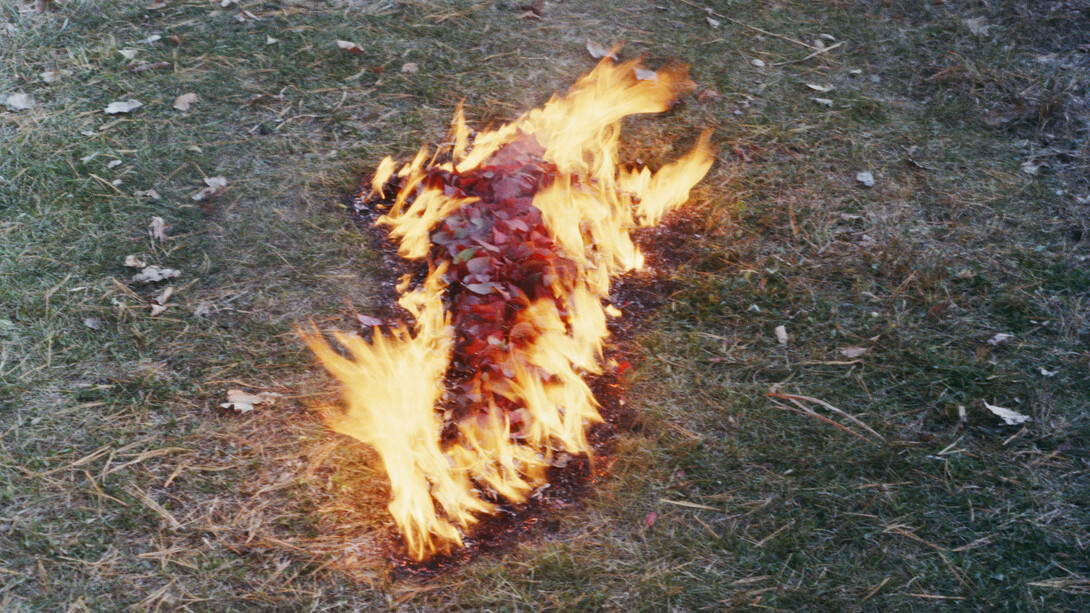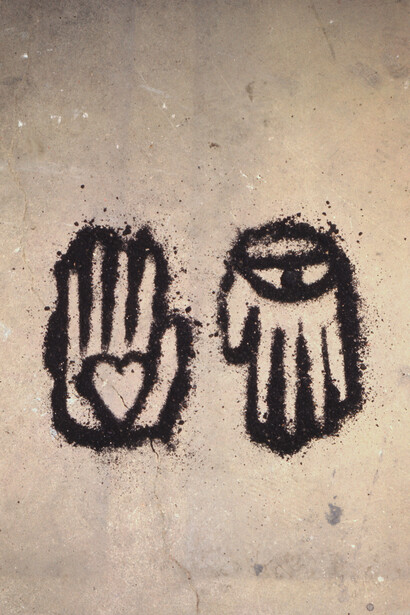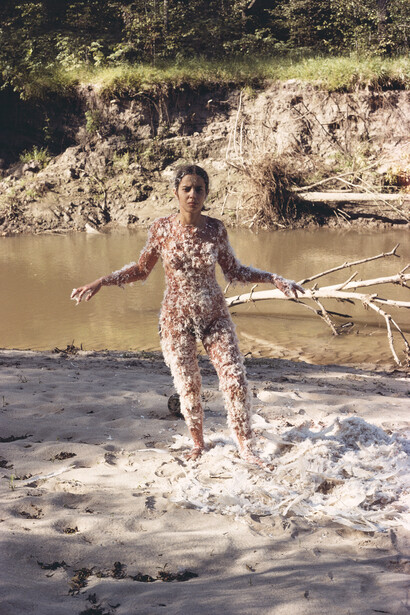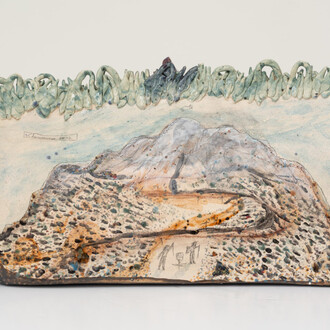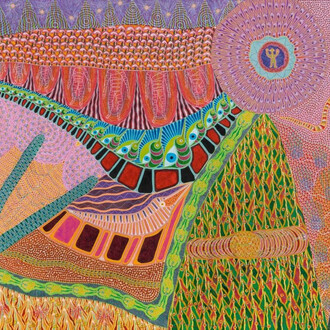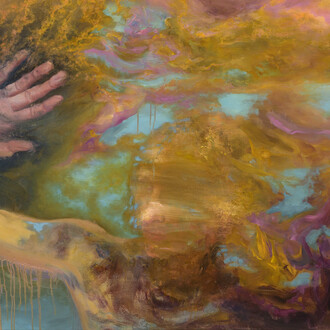Plugging into Mexico was like going back to the source, being able to get some magic just by being there.
(Ana Mendieta)
Marian Goodman Gallery is delighted to announce Back to the Source, our inaugural exhibition of the work of Ana Mendieta (1948-1985) which will be on view in our Tribeca space from 7 November 2025 - 17 January 2026.
Back to the source presents seminal works from 1972-1985, a prolific period of Mendieta’s work, spanning stages of time spent in Iowa, Mexico, and Cuba, including seven digitally remastered films, photographic works, newly available photographic prints and drawings, and ephemeral sculpture.
Ana Mendieta was a pioneer and innovator whose oeuvre spanned painting, drawing, photography, film/video, sculpture, and site-specific works. Her singular interventions in the landscape embraced nature and disrupted societal conventions. Exiled from her homeland of Cuba where she was born in 1948, Mendieta spent her childhood and formative years in Iowa, in the 1960s. She later studied art at the University of Iowa, first as a painter, then later in performative art, a move which would ultimately change her approach as an artist. Her body of work testifies to a passionate engagement with themes of exile and displacement, reconnecting with the earth, and the search for belonging and origin, through power, magic and the universal.
Creating a rich and diverse body of work that included ephemeral sculptures, Mendieta, in her film and photographic works, captures time and process through direct actions which transport her beyond conventional materials to the realm of the intangible and impermanent, using nature as a collaborator. With her body as material, and driven by nature’s symbolic meaning, she sought to integrate power, magic and knowledge into her work, using natural materials as well as the four elements –earth, air, fire, and water. Feathers, flowers, branches, moss, fireworks and gunpowder were easily accessible and were often part of ritual practices to return her to the land and connect her to the universal.
These obsessive acts of reasserting my ties with the earth is really a manifestation of my thirst for being. In essence my works are the reactivation of primeval beliefs. The photographs become the afterimage of primordial remembrances at work within the human psyche.
(Mendieta, Proposal for Rome Prize Fellowship, 1983)
Using the earth as a sculptural medium – which she molded, impressed, and burned – Mendieta conveyed notions of existence, resurgence and renewal through site-inclusive works that were exquisitely ethereal and transitory. Contemplative and existential meditations on mortality and the natural world, these works were part of living processes.
An interest in themes of transformation – birth, life, death, regeneration – is evident throughout her oeuvre, and can be seen in Ñañigo Burial, 1976, installed in the first floor gallery. Comprised of black candles which originally outlined the contours of the artist’s body, its title points to the influence of the Abakuá society of Cuba, also known as Ñañiguismo, which offers spiritual protection to its members. Drawn to this and Afro-Cuban Santeria traditions, which blend the Yoruba religion of West Africa, Roman Catholicism, and Spiritism, Mendieta sought magic and the divine to regenerate life within her work and through nature.
Mendieta developed the Silueta Series from 1973-1980, first inspired by a visit to Mexico, in a signature period of expression in which she utilizes her own body, prior to removing herself from it. Moving away from traditional notions of sculpture as object, and towards the experience of living process and geological time as a medium, Mendieta rendered silhouettes through hieroglyphs of imprints, outlines, and absences within the earth, which were left to erode and return to it.
Their timeless memory is preserved through related photographic works, such as Silueta Sangrienta, 1975, a new print. Other silueta works followed in 1976-79, such as Silueta series (Tree of life), 1978, and a selection which are presented here. A color print, Incantation to Olokun-Yemaya Encantación a Olokún-Yemayá (Incantation to Olokun-Yemaya), 1977, depicts a silueta in the earth, invoking two identities of the West African Yoruba goddess known as a river mother and fertility deity. A work from 1978 shows a subtle silueta formed from natural materials between two tree branches, and the other, a spiral impression in the earth, creating a metaphorical association with land-based work- in this case with a human scale silueta at its center. In other works, figures are carved into the earth, such as in Black Venus, 1980, a black and white photograph which features an earthen imprint of a female form. Its title refers to a legendary symbol against slavery, an affirmation, as Mendieta writes, of those who are free and refuse to be colonized. This work is in dialogue with La Venus negra, 1981, which also features a detailed imprint resembling the human form, created on a rock surface — its deliberate placement on stone suggesting a connection between the human form, nature and the earth. Black and white photographs of two Sandwoman works from 1983 document outlines of organic female forms hand carved in the sand, reiterating temporality and impermanence. A newly framed and never before seen small-scale drawing of the hand with heart –– imparts the artist’s fascination with ancient Egypt, hieroglyphs, and cave drawings, reiterating her journey “back to the source.” These works are accompanied by an additional selection of Untitled works on paper from 1978-79 and 1983-1985, depicting organic forms.
I have thrown myself into the very elements that produced me, using the earth as my canvas and my soul as my tools.
(Mendieta, Proposal for the New York State Council on the Arts, 17 March 1982)
On view are seven films created between Iowa and Mexico. which span from 1972 to 1978, and in which we see a representation of the various elements – from fire, water, and air, to gunpowder, and blood. The earliest of these, Chicken movie, chicken piece, 1972, originally filmed in Super 8, documents a primitive action in which Mendieta holds a decapitated chicken, a familiar form of sacrifice in Santería resulting in a splattering of blood, which thematically connects to universal and spiritual power. The theme of self-transformation is introduced in Blood + feathers, captured in a recently discovered 1974 color photo in which Mendieta initiates a transfer of energy, covering her body in feathers and blood, as if to divine herself as an unearthly avian spirit, becoming a bird or, as she had said, “the white cock.” Silueta del laberinto (Laberinth blood imprint), 1974, shot the same year, begins with a silueta outline on a ceremonial site near Oaxaca, Mexico, the contours of which are flooded beyond their recessed lines, spilling beyond the corporeal outline to resemble an organic shape. In *Silueta del laberinto, one of the first films in which Mendieta uses a silhouette to stand in for her own body, she also circumnavigates the site's labyrinthian architecture with a handheld camera, anticipating later works.
Energy charge, a silent 16 mm film from 1975, evokes an avatar of Laberinth blood imprint, by featuring a figure with upraised arms emerging from a dark landscape which transforms into a bright red silueta shape before vanishing, the polarizing color recalling its memory. Two more films, each from the Silueta series, are additionally sanguine in nature. Silueta sangrienta, made in Iowa City in 1975, shows the artist naked and face up with uplifted arms in the excavated earth, which is later emptied, then re- filled with red pigmented liquid, in which she lies face down and partially submerged. Untitled: silueta series, 1978, filmed at Old Man’s Creek, Iowa, introduces the element of fire, showing hands created from clay emerging from a tree trunk which then becomes engulfed with rising flames. Silueta de Arena, 1978, depicts a silueta emerging from the shallow waters of a riverbank, forming an island unto itself.
On the second floor, the suite of color photographs, Body tracks, 1974, traces an early action documented in Iowa prior to Mendieta’s move into nature. Here Mendieta uses tempera to create imprints of her hands, repeated through a performative gesture of kneeling and dragging her red hands down to create markings in two parallel tracks on pink fabric.
Corazon, 1975, a still color photograph, was made following the creation of Mendieta’s Super 8 film, Grass breathing, in Iowa. In the latter, she becomes one with the earth, positioning herself beneath a mound of earthen sod in a meadow, inhaling and exhaling, the movement of her body causing the grassy verdant mound to rise and fall, then rest.
Two Untitled works from 1981 trace sand sculptures made in relief on Guanabo Beach, Havana. An extension of Mendieta’s silueta practice, these works mark a turn from Mendieta’s earlier investigations of fire, air, and water towards more grounded explorations of rock and earth, evoking the Neolithic and prehistoric forms that long held a fascination for her, and which solidify into low relief sand sculptures. The forms invoke the abstract and curving forms of the Taíno goddess etched against walls of the Jaruco caves. This period of her work represents a longing fulfilled and a liberation – freed by the creation of art made from the unconscious and from prehistoric remembrance, bringing her back to the source.
